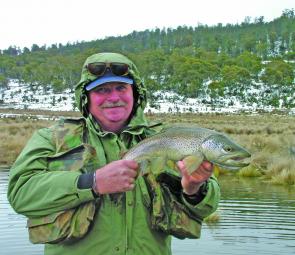What a winter it has been in Tasmania and we probably still have plenty to go.
It’s been a real old fashion winter in the Tasmanian highlands; cold, wet and very snowy.
One old timer, one of Tasmania’s last mountain men said to me the other day that he thought he would never see a winter like this again.
What can we expect for September? At the time of writing the southern highlands lakes and lagoons are either full or filling fast with icy cold water; this will set us up for a great season. Because of the lower temperatures in the shallows, there probably won’t be much sight fishing in the shallows for the fly fisher until around the mid to later part of September, but please, try to prove me incorrect!
After the poor results following the netting and stunning surveyor the IFS conducted on the three waters in the Brady’s chain of lakes earlier in the winter, there has been a concentrated stocking program with adult fish from the Great Lake and Arthur’s Lake as well as many fingerlings also being released.
These adult fish will be hungry eager to attack lures both trolled and cast from the shore by September. In Brady’s the area around the boat ramp at the White Water end and the dam wall are always reliable early season locations.
The best bet for the fly fisher if the water levels are up which they are sure to be, will be the shack shore, especially either side of boat ramp. This area often has plenty of food available for the trout, especially corby grubs and spiders that have been flushed out.
If a fish or two is feeding on floating grubs or spiders, a bushy nymph about a size 10 or size 12 floated in the surface does well. We’ve had good success on a Hares Ear with the fibres well picked out, a Black Fuzzle Bugger or MK2 Woolly Bugger will get some attention if nothing is showing.
Lake Binney and Tungatinah will also have plenty of attention in September, the Binney wall is always reliable with many good fish coming to lures both hardbodied lures and soft plastics. The shallow tussock lined bay adjacent to the Lyell Highway is a standout for Tungatinah Lagoon; the browns cruise this area looking for frogs and whatever else they can find, it’s nice and sheltered also if the wind is having a go.
Bronte is always the premier water in the Southern Highlands in early spring for the fly fisher. Any of the shallow shores are worth a look, and favourite bays are Woodward’s, Tailers, Hut Bay and the legendary Long Shore. When the lagoon is extra full the water backs right up into the high tussocks that make fishing very difficult, the fish are there but getting a decent cast to them can be a nightmare.
The Sloane’s Rabbit Fur fly is a must have for Bronte but it must be tied on a light hook so it won’t sink to fast and get lost in the grasses. This pattern is a great general fly imitating a host of varied trout food such as frogs, grubs and just something that looks nice to eat.
The Broadwater always fishes well in September and generally the tussocks aren’t as thick here around the margins. I’m always amazed how adventuress the foraging fish can be a here especially towards evening. Stay well back from the water’s edge and watch, often a tail or dorsal fin will show in water that you would swear isn’t deep enough to conceal the rest of the fishes body.
For these secretive trout even in the very early days of September, I’ll use a big bushy fly such as a Zulu for a strike indicator with size 12 or 14 007 nymph suspended no more than a hands width from bend of the indicator fly.
When Pine Tier spills, the northern bay backs right up into the paddock creating a wonderful fly fishing shore ideal for tailers, early mornings and late evenings will have plenty of fish showing, this is another spot where wading out to far is a real mistake.
The trout come right in close tailing and foraging around the reeds, tussocks and other bits of structure. If the fish are in an aggressive mood, a Rabbit fur Fly, small Mrs Simpson or a small Woolly Bugger will get pounced upon if not the indicator dry trick with a 007 or a Scintilla Stick Caddis underneath will get noticed.
Tasmania’s original brook trout-only water always fishes at it’s best in the early months of the season. It can be an adventure getting to the lagoon but once there, the surrounds and of course the lagoon are worth the trip.
I like the eastern shore, most of the success that I and companions have had has been casting lures from this side of the Lagoon, you never know, you might latch onto one of the 2kg and better beauties that are landed here each season.
Reads: 2896
The productive flooded margins of Woodward’s Broadwater.

Flyfishing legend Ken Orr with a better than average September flood water feeder.




